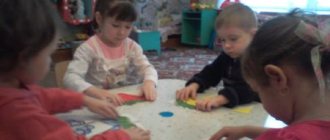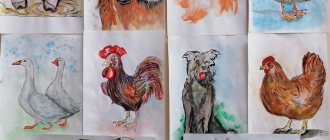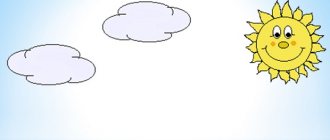Summary of a lesson by a teacher-psychologist in a junior group on the topic “Ladybug”.
Panteleeva Marina Viktorovna
Educational psychologist
MBDOU D/S No. 6 Fairy Tale Municipal District "Baryshsky District"
Summary of a lesson for a teacher-psychologist in a junior group on the topic
«
Ladybug
».
Target
: help children adapt to the conditions of kindergarten.
Tasks:
- creating a positive emotional mood in the group
— development of the ability to act according to the player’s rules
- development of coordination of movements, general and fine motor skills, orientation in one’s own body.
– development of visual perception (color, shape, size of objects)
- development of attention, speech and imagination.
Materials:
toy ladybug (preferably round in shape, large and small cars, dolls, cubes, etc.; green gouache, sheet with a picture of a ladybug (for each child, brush.
Progress of the lesson.
A psychologist shows children a toy ladybug.
Psychologist: A ladybug came to visit us. Look how beautiful she is! Let's say hello to her. Children look at the ladybug and say hello to it.
Psychologist: Guys, imagine that our ladybug has flown. Come on, let's try to catch her!
The psychologist pretends that he is trying to catch an imaginary bug and performs grasping movements above his head: with one hand, the other, with both hands at the same time. Children repeat the movements shown.
Psychologist: let's unclench our fists and see if we could catch the ladybug.
The children, following the psychologist, slowly unclench their fists.
Psychologist: Here is our bug! Give him both your palms.
Children, following the psychologist, join their open palms, imagining that they are holding an imaginary bug.
The psychologist tells a nursery rhyme and shows the movements. The children repeat after him.
Ladybug (children shake their palms rhythmically)
Fly to the sky (make waves with crossed hands)
Bring some bread (they wave their hands towards themselves)
Black and white, (clapping hands rhythmically)
Just not burnt! (They shake their index finger)
Psychologist: The ladybug is frozen and cannot fly. Let's warm her with our breath. Children breathe on their palms.
Psychologist: The ladybug is warm, let's blow it off our palm. Children try to blow away a ladybug.
Psychologist: now guys, let’s turn into ladybugs ourselves.
We are spinning around ourselves (children are spinning)
And they turned into ladybugs. (show named body parts)
Ladybugs, show me yours
Heads, noses, mouths,
Handles - wings, legs, tummies.
Psychologist: wonderful! And now we will play the game “ ladybugs and the wind ”
The sun is shining, ladybugs are crawling on the floor.
Psychologist: an angry cold wind blew and turned the bug over. Children roll over onto their backs, moving their relaxed legs and arms.
Summary of a lesson by a teacher-psychologist with young children
Summary of educational activities with young children. The sun is radiant
Progress of the GCD:
Greeting (conducted by an educational psychologist): Hello, golden sun! Hands spread to the sides like the rays of the sun Hello, blue sky! We raise our hands up, straight, Hello, free breeze! Swing your arms from side to side Hello, little friend! Children hug Children sit in a circle. “Morning” by E. Grieg is playing. Listen. The sun appears (group teacher) Teacher-psychologist: The sun is visiting us. In the morning the sun rises. It shines all day long. And, of course, he gets tired - evening comes. When the sun sets across the river, you won’t mind relaxing. The sun needs rest. And night comes. The night will pass. And during the day the sun will be in the sky again. To warm the earth, we need light from the window. M.Druzhinina. Sun (group teacher): I walk around the world. I’m not too lazy to walk and shine. Where there is sun, there is no night. Where the sun is, it’s a clear day! Teacher-psychologist: Hello, hello, sunshine! Shine brighter for us! Help us, sunshine, to grow stronger and grow! Sunny wants to meet you. (Sunny comes up to each child and says hello, taking them by the hands). Guys, let's play with the sun. Exercise “Sun” (collection “Top-clap, kids” by A.I. Burenin). Children sit on their haunches with their palms under their cheeks. This is how the sun rises, Children slowly stand up, raising their hands up. Higher, higher, higher. By night the sun will set. Squat down, palms under the cheek. Below, below, below. Okay, okay. Clap your hands. The sun laughs. And under the sun we Spin, with our hands on our belts. It's fun to sing. Teacher-psychologist: Look, the sun has palms. Show your palms to the sun. Exercise “Palm” (collection “Top - clap, kids” by A.I. Burenin). Give me your palm, my little one. The teacher with the sun approaches everyone. I will stroke your palm. child and the sun strokes his palm. Finger game "Sun". Fingers clenched into fists. In the morning the sun woke up, They rotate their fists in front of them. It smelled sweet, sweet. Pull your fists up. Its rays have opened. They open their fists, spreading their fingers. And the whole earth was illuminated. They perform “flashlights”. Teacher-psychologist: Look how many suns we have (yellow circles are on the floor). What do they lack? Luchikov! Let's make some rays for our suns (yellow clothespins). Teacher-psychologist: Now let’s say goodbye to the sun with our palms
We recommend watching:
Abstract of GCD in the younger group “In the World of Toys” Game technologies in speech therapy work with preschoolers Game guide for the development of fine motor skills for the younger group of kindergarten Educational game for younger preschoolers Flower
Similar articles:
Summary of a lesson for children 2-3 years old on the topic “My beloved dad!”
The tasks that the psychologist and educator set for themselves:
— Creating a positive emotional mood in the group ;
— Development of the ability to act in accordance with the rules of the game;
— Development of coordination of movements, general and fine motor skills, orientation in one’s own body;
— Development of visual perception (color, shape, size of objects);
— Development of attention, speech and imagination.
Materials:
Toy " Sun ".
Progress of the lesson:
Greetings.
The psychologist shows the children the soft toy Sun.
Educator: it was night, all the children were sleeping in their beds, morning came and the children came to our kindergarten. We are very glad to see you all!
Psychologist: And Sunny came to visit . Look how beautiful and bright it is! Let's say hello to him:
Let's hold hands friends
Let's smile at each other
We wish you all the best
And let's say: “Hello sun !” (Children look at the sun , say hello to it. The teacher offers to determine the color, shape and size of the toy, then, together with the children, counts the rays of the sun ).
Psychologist: Guys, imagine that our sun has flown to its own sky. Come on, let's try to catch him!
Children perform grasping movements above their heads: with one hand, with the other, with both hands at the same time (The teacher helps the children catch the sun , performing the same movements).
Psychologist: Let's unclench our fists and see if we were able to catch at least the rays from our bright sun .
The children, following the psychologist, slowly unclench their fists.
Psychologist: Now blow on the rays and let them fly towards the sun .
- Guys, let's turn into the sun .
We spun around ourselves and turned into the sun (Spinning).
- Sunny, show me your head, nose, mouth, arms - rays, legs, tummy (Show the named parts of the body).
Psychologist: Great! You showed everything correctly, well done! And now we will play the game: “ Sunshine and Rain ”
— The sun , shining into our room through the window.
— We clapped our hands, we were very happy about the sun !
- Guys, it’s starting to rain, quickly hide under our umbrella (The guys stand under the umbrella next to the psychologist and teacher).
Educator: And now it’s time for our fingers to play.
Finger gymnastics:
- One, two, three, four, five (to the beat of the words, one by one, starting with the little finger, bend the fingers on the right hand).
Let's count the fingers (now we straighten the fingers one by one, starting with the thumb, on the same hand).
Everyone has been gathered (we clench our palm into a fist).
We counted (we open our palms and keep our fingers spread).
It turned out to be exactly five (we alternately touch the fingertips of the right hand with the index finger of our left hand). After this, we change hands and perform all the exercises first, but with the left hand.
Psychologist: Let's draw a sun in the air , show how round it is. (The children, following the psychologist, draw a circle in the air: with one hand, the other, the other, both hands at the same time (if necessary, the psychologist can take the children’s hands in his own and show them how rotational movements are performed).
Now let’s dance to the music with the sun , look out the window guys, notice what a joyful, fine day it is today (Music is turned on, children are dancing with their teacher and psychologist).
Educator: Guys, the sun really enjoyed visiting us , but it’s time to say goodbye. Let's hug the sun and each other . Goodbye, sunshine , see you again (The psychologist, holding a soft toy sunshine , says goodbye to the children and leaves).



